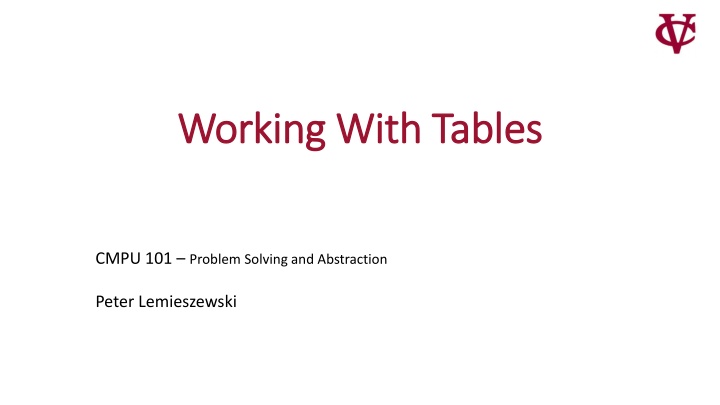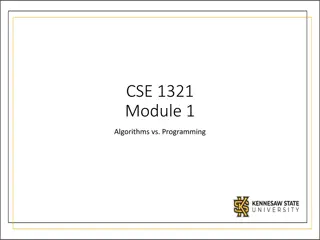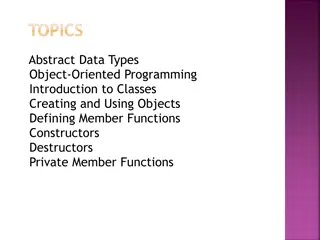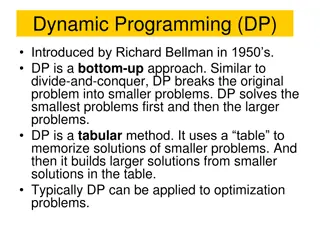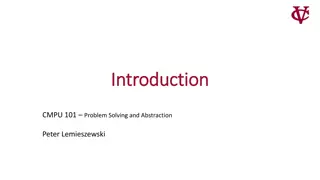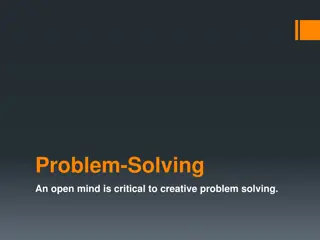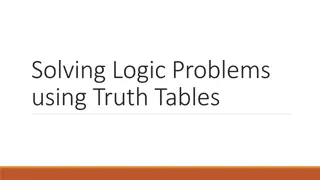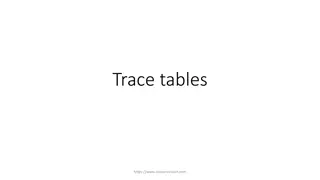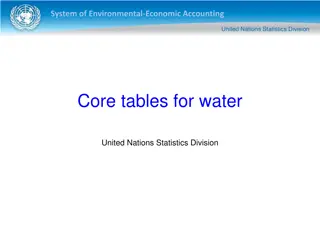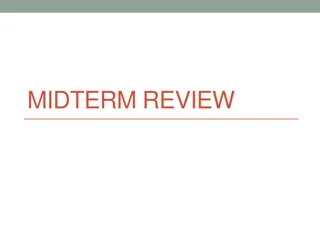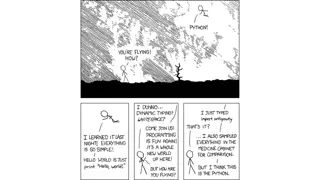Working With Tables - Problem Solving and Abstraction
Dive into the complexities of data types and population functions in programming. Explore how to retrieve specific data efficiently using Pyret language features. Discover a practical example of looking up town populations in New York, highlighting the importance of accurate data representation and retrieval.
Download Presentation

Please find below an Image/Link to download the presentation.
The content on the website is provided AS IS for your information and personal use only. It may not be sold, licensed, or shared on other websites without obtaining consent from the author.If you encounter any issues during the download, it is possible that the publisher has removed the file from their server.
You are allowed to download the files provided on this website for personal or commercial use, subject to the condition that they are used lawfully. All files are the property of their respective owners.
The content on the website is provided AS IS for your information and personal use only. It may not be sold, licensed, or shared on other websites without obtaining consent from the author.
E N D
Presentation Transcript
Working With Tables Working With Tables CMPU 101 Problem Solving and Abstraction Peter Lemieszewski
Data Types Data Types Here are some data that can be represented with what we ve seen so far: A picture of a dog The population of Azerbaijan The complete text of the Baghavad Gita Whether or not I ate breakfast this morning Image Number String Boolean CMPU 101:Problem Solving and Abstraction 3/8/2025 2
A more complex example A more complex example What if we wanted to write a program to look up the population of any town in New York? We can consider the last two census years 2010 and 2020. Next slide has a way to get us started CMPU 101:Problem Solving and Abstraction 3/8/2025 3
The Population Function (plain text) The Population Function (plain text) fun population(municipality :: String, year :: Number) -> Number: doc: "Return population of the municipality for the given year" if municipality == "New York": if year == 2010: 8175133 else if year == 2020: 8804190 else: raise("Bad year") end else if municipality == "Poughkeepsie": if year == 2010: 43341 else if year == 2020: 45471 else: raise("Bad year") end else: raise("Bad municipality") end end Data from: Local Government 2020 Census Interactive Dashboard wwe1.osc.state.ny.us/localgov/2020-census-interactive-dashboard.htm CMPU 101:Problem Solving and Abstraction 3/8/2025 4
The Population Function ( The Population Function (pyret pyret) ) CMPU 101:Problem Solving and Abstraction 3/8/2025 5
The Population Function ( The Population Function (pyret pyret nested if) nested if) Just pointing out nested if stmts here! CMPU 101:Problem Solving and Abstraction 3/8/2025 6
Whats all this then? ( What s all this then? (pyret pyret: new lang. feature) : new lang. feature) CMPU 101:Problem Solving and Abstraction 3/8/2025 7
Whats all this then? ( What s all this then? (pyret pyret: raise) : raise) raise stops Pyret from evaluating the program and displays an error message to the user. This is different than returning a value, which lets Pyret continue as normal. Our "population" function returns numbers, but if it can't return a number, it will display one of these error messages. This is a convenient thing to do when dealing with unexpected inputs. Data is not always pure! CMPU 101:Problem Solving and Abstraction 3/8/2025 8
A more complex example revisited A more complex example revisited What if we wanted to write a program to look up the population of any town in New York? The approach used is not the best approach Not at all! But why? Let s take another look at the code CMPU 101:Problem Solving and Abstraction 3/8/2025 9
The Population Function ( The Population Function (pyret pyret) ) CMPU 101:Problem Solving and Abstraction 3/8/2025 10
The Population Function ( The Population Function (pyret pyret) ) We have New York City We have Poughkeepsie We have none of the other 1528 municipalities! CMPU 101:Problem Solving and Abstraction 3/8/2025 11
How to consider functions How to consider functions KEY IDEA: Separate data from code computations. Then, we can reuse the data in as many functions as we want. Another KEY IDEA: Table-Driven Programming (my term!) i.e. Organize data into tables and we can tailor functions based on tables CMPU 101:Problem Solving and Abstraction 3/8/2025 12
Whats a Table? What s a Table? It is tabular data made up of rows/columns similar to what you would see in a spreadsheet CMPU 101:Problem Solving and Abstraction 3/8/2025 13
Defining a Table in Defining a Table in pyret pyret Name of the table Column Headings are named here Dileneate data using commas CMPU 101:Problem Solving and Abstraction 3/8/2025 14
Defining a Table in Defining a Table in pyret pyret Name of the table Column Headings are named here Q: What type of data makes up a single row? Dileneate data using commas CMPU 101:Problem Solving and Abstraction 3/8/2025 15
Defining a Table in Defining a Table in pyret pyret adding data types adding data types municipalities = table: name :: String, kind :: String, pop-2010 :: Number, pop-2020 :: Number row: "Adams", "Town", 5143, 4973 row: "Adams", "Village", 1775, 1633 row: "Addison", "Town", 2595, 2397 row: "Addison", "Village", 1763, 1561 row: "Afton", "Town", 2851, 2769 #careful if you copy/paste from here, #all whitespace is not the same! end 3/8/2025 CMPU 101: Problem Solving and Abstraction 16
Steps to Create the table Steps to Create the table 1. Name the table (minicipalities here) & click Run ( mi and not mu here) -> table is created 2. Type in minicipalities & press enter key -> table is displayed 3. Good idea to simply include lines 2-7 in your programs, even if they aren t necessary right now 4. (again) be careful when doing copy/paste, tab keys and space characters have different behavior CMPU 101:Problem Solving and Abstraction 3/8/2025 17
Publish or Perish Publish or Perish So much data, so little time! We can share tables using the Publish menu button rather than typing/copying/pasting/whatever Important for sharing ginormous tables instead of gathering data yourself CMPU 101:Problem Solving and Abstraction 3/8/2025 18
Publish or Perish (2) Publish or Perish (2) End result is a sharable link! That we can, umm, type/copy/paste/whatever. CMPU 101:Problem Solving and Abstraction 3/8/2025 19
Publish or Perish (3) Publish or Perish (3) End result is a sharable link! That we can, umm, type/copy/paste/whatever. CMPU 101:Problem Solving and Abstraction 3/8/2025 20
Publish or Perish (4) Publish or Perish (4) End result is a sharable link! That we can, umm, type/copy/paste/whatever. CMPU 101:Problem Solving and Abstraction 3/8/2025 21
Publish or Perish (5) Publish or Perish (5) Here we use the table called minicipalities (as if we compiled the data ourselves) CMPU 101:Problem Solving and Abstraction 3/8/2025 22
Turning the Tables Turning the Tables Let s use the complete set of data from the NY State website! CMPU 101:Problem Solving and Abstraction 3/8/2025 23
Turning the Tables (2) Turning the Tables (2) You should be able to copy/paste these lines into pyret to get the same results: (It worked on my machine at home!) # Load textbook functions for working with tables include shared-gdrive("dcic-2021", "1wyQZj_L0qqV9Ekgr9au6RX2iqt2Ga8Ep") # Load the full municipalities table include shared-gdrive("municipalities", "18eBAc9RcBfDQDpgjUkBQRj7LjgvAaXFs") #Click "Run" then #To see the tabular data in pyret, #Type in "municipalities" sans quotes (the name of the table) on RHS CMPU 101:Problem Solving and Abstraction 3/8/2025 24
Ok, Ive got a table. Now what? Ok, I ve got a table. Now what? Now that we have the data in Pyret, we can write programs to crunch the numbers i.e. analyze the data! We ll need to learn some basic table manipulation functions first CMPU 101:Problem Solving and Abstraction 3/8/2025 25
Extracting Rows Extracting Rows CMPU 101:Problem Solving and Abstraction 3/8/2025 26
Row Data Row Data The data type returned by .row-n is a Row. We can access a value in the row by specifying the name of a column: municipalities.row-n(0)["name"] "Adams" A note about the format of the above statement The parentheses ( ) are saying that row-n is a function The square brackets [ ] are saying to look up or extract the value of a particular column (the column named name here) CMPU 101:Problem Solving and Abstraction 3/8/2025 27
Row Data as input to a function Row Data as input to a function We can write a function that takes a row as input: fun population-decreased(r :: Row) -> Boolean: doc: "Return true if the municipality's population went down between 2010 and 2020" r["pop-2020"] < r["pop-2010"] end If you remember Friday s lab, we can safely omit the explicit checks using if statements when returning a Boolean. if r["pop-2020"] < r["pop-2010"]: true else: false end CMPU 101:Problem Solving and Abstraction 3/8/2025 28
Defining a Table in Defining a Table in pyret pyret adding data types adding data types municipalities = table: name :: String, kind :: String, pop-2010 :: Number, pop-2020 :: Number row: "Adams", "Town", 5143, 4973 row: "Adams", "Village", 1775, 1633 row: "Addison", "Town", 2595, 2397 row: "Addison", "Village", 1763, 1561 row: "Afton", "Town", 2851, 2769 #careful if you copy/paste from here, #all whitespace is not the same! end 3/8/2025 CMPU 101: Problem Solving and Abstraction 29
Filtering data and (re)Ordering Tables Filtering data and (re)Ordering Tables From this point on, we will need to include the textbook functions via: # Load textbook functions for working with tables include shared-gdrive("dcic-2021", "1wyQZj_L0qqV9Ekgr9au6RX2iqt2Ga8Ep") (I ll provide it with sample code; you ll just need to remember to copy/paste into your programs) 3/8/2025 CMPU 101: Problem Solving and Abstraction 30
Filtering data and (re)Ordering Tables Filtering data and (re)Ordering Tables From this point on, we will need to include the textbook functions via: # Load textbook functions for working with tables include shared-gdrive("dcic-2021", "1wyQZj_L0qqV9Ekgr9au6RX2iqt2Ga8Ep") (I ll provide it with sample code; you ll just need to remember to copy/paste into your programs) 3/8/2025 CMPU 101: Problem Solving and Abstraction 31
Filtering data and (re)Ordering Tables Filtering data and (re)Ordering Tables Can we synthesize the data in municipalities to create a new table showing only cities where the population decreased between 2010 and 2020? 3/8/2025 CMPU 101: Problem Solving and Abstraction 32
Filtering data and (re)Ordering Tables Filtering data and (re)Ordering Tables Can we synthesize the data in municipalities to create a new table showing only cities where the population decreased between 2010 and 2020? Spoiler Alert: YES, we can do that! 3/8/2025 CMPU 101: Problem Solving and Abstraction 33
Brainstorming ways to do this: Table as parameter Brainstorming ways to do this: Table as parameter # Create function that accepts a table and finds all municipalities with pop. decrease fun filter-population-decreased(t :: Table) -> Table: if population-decreased(t.row-n(0)): ... # Keep row 0 if population-decreased(t.row-n(1): ... # Keep row 1 else: ... # Don't keep row 1 end else: ... # Don't keep row 0 end end CMPU 101:Problem Solving and Abstraction 3/8/2025 34
Brainstorming ways to do this (2) Brainstorming ways to do this (2) fun filter-population-decreased(t :: Table) -> Table: if population-decreased(t.row-n(0)): ... # Keep row 0 if population-decreased(t.row-n(1): ... # Keep row 1 else: ... # Don't keep row 1 end else: ... # Don't keep row 0 end end We would need 1500+ if statements? Noooooooo Good idea, but awful implementation. We don t really need to write code like this! We can write general, all-purpose code to handle this. CMPU 101:Problem Solving and Abstraction 3/8/2025 35
This is the way This is the way filter-with can be used as a function to create a table with the desired set of rows filter-with(municipalities, population-decreased) Two parameters 1. Our (municipalities) table 2. A function that filter-with uses. It will accept a row as a parameter and return a Boolean In other words, filter-with will iterate through the rows in our table, keeping what fits its criterion A place with a decrease in population! 3/8/2025 CMPU 101: Problem Solving and Abstraction 36
This is the way more generally This is the way more generally filter-with(t :: Table, keep :: (Row -> Boolean)) -> Table Read this as: Given a table and a predicate on rows, returns a table with only the rows for which the predicate returns true. Again, two parameters 1. A data type of table 2. A keep function (the predicate) that filter-with uses. It will accept a row as a parameter and return a Boolean 3/8/2025 CMPU 101: Problem Solving and Abstraction 37
A similar example with municipalities A similar example with municipalities We can also use filter-with to get a table made up of just the towns: fun is-town(r :: Row) -> Boolean: doc: "Check if a row is for a town" r["kind"] == "Town" end filter-with(municipalities, is-town) 3/8/2025 CMPU 101: Problem Solving and Abstraction 38
Expanding our options Expanding our options We can also order the data by the values in one column: order-by(municipalities, "pop-2020", false) order-by(t :: Table, colname :: String, sort-up :: Boolean) -> Table Given a table and the name of a column in that table, return a table with the same rows but ordered based on the named column. If sort-up is true, the table will be sorted in ascending order, otherwise (false) it will be in descending order. 3/8/2025 CMPU 101: Problem Solving and Abstraction 39
We can combine all of these too! We can combine all of these too! How do we create a function that gives us the town with the smallest population? ? 3/8/2025 CMPU 101: Problem Solving and Abstraction 40
We can combine all of these too! We can combine all of these too! How do we use the order-by function to give us the town with the smallest population? order-by( filter-with(municipalities, is-town), "pop-2020", true).row-n(0) 3/8/2025 CMPU 101: Problem Solving and Abstraction 41
Using what we have seen Using what we have seen PROBLEM: We want to know the fastest-growing towns in New York. CMPU 101:Problem Solving and Abstraction 3/8/2025 42
Using what we have seen (2) Using what we have seen (2) PROBLEM: We want to know the fastest-growing towns in New York. i.e. we want a table containing only towns, sorted by the percent change in population. Let s break the problem statement into manageable parts CMPU 101:Problem Solving and Abstraction 3/8/2025 43
Using what we have seen (3) Using what we have seen (3) PROBLEM: We want to know the fastest-growing towns in New York. i.e. we want a table containing only towns, sorted by the percent change in population. Let s break the problem statement into manageable parts Make a new table and 1. Filter out the cities, etc. (i.e. only towns) 2. Calculate percentage change in population 3. Build a (new) column for percentage change 4. Sort the table based on that new column in descending order CMPU 101:Problem Solving and Abstraction 3/8/2025 44
Building a solution (1) Building a solution (1) PROBLEM: We want to know the fastest-growing towns in New York. i.e. we want a table containing only towns, sorted by the percent change in population. Let s break the problem statement into manageable parts Make a new table and 1. Filter out the cities, etc. (i.e. only towns) towns = filter-with(municipalities, is-town) 2. Calculate percentage change in population 3. Build a (new) column for percentage change 4. Sort the table based on that new column in descending order CMPU 101:Problem Solving and Abstraction 3/8/2025 45
Building a solution (2) Building a solution (2) PROBLEM: We want to know the fastest-growing towns in New York. i.e. we want a table containing only towns, sorted by the percent change in population. Let s break the problem statement into manageable parts Make a new table and 1. Filter out the cities, etc. (i.e. only towns) towns = filter-with(municipalities, is-town) 2. Calculate percentage change in population fun percent-change(r :: Row) -> Number: doc: "Compute the percentage change for the population of the given municipality between 2010 and 2020" (r["pop-2020"] - r["pop-2010"]) / r["pop-2010"] end 3. Build a (new) column for percentage change 4. Sort the table based on that new column in descending order CMPU 101:Problem Solving and Abstraction 3/8/2025 46
Building a solution (3) Building a solution (3) PROBLEM: We want to know the fastest-growing towns in New York. i.e. we want a table containing only towns, sorted by the percent change in population. Let s break the problem statement into manageable parts Make a new table and 1. Filter out the cities, etc. (i.e. only towns) towns = filter-with(municipalities, is-town) 2. Calculate percentage change in population fun percent-change(r :: Row) -> Number: doc: "Compute the percentage change for the population of the given municipality between 2010 and 2020" (r["pop-2020"] - r["pop-2010"]) / r["pop-2010"] end 3. Build a (new) column for percentage change towns-with-percent-change = build-column(towns, "percent-change", percent-change) 4. Sort the table based on that new column in descending order CMPU 101:Problem Solving and Abstraction 3/8/2025 47
Building a solution (4) Building a solution (4) PROBLEM: We want to know the fastest-growing towns in New York. i.e. we want a table containing only towns, sorted by the percent change in population. Let s break the problem statement into manageable parts Make a new table and 1. Filter out the cities, etc. (i.e. only towns) towns = filter-with(municipalities, is-town) 2. Calculate percentage change in population fun percent-change(r :: Row) -> Number: doc: "Compute the percentage change for the population of the given municipality between 2010 and 2020" (r["pop-2020"] - r["pop-2010"]) / r["pop-2010"] end 3. Build a (new) column for percentage change towns-with-percent-change = build-column(towns, "percent-change", percent-change) 4. Sort the table based on that new column in descending order fastest-growing-towns = order-by(towns-with-percent-change, "percent-change", false) CMPU 101:Problem Solving and Abstraction 3/8/2025 48
Full solution almost(!) Full solution almost(!) PROBLEM: We want to know the fastest-growing towns in New York. fun percent-change(r :: Row) -> Number: doc: "Compute the percentage change for the population of the given municipality between 2010 and 2020" (r["pop-2020"] - r["pop-2010"]) / r["pop-2010"] end Fun is-town(r :: Row) -> Boolean: doc: "Check if a row is for a town" r["kind"] == "Town" end towns = filter-with(municipalities, is-town) towns-with-percent-change = build-column(towns, "percent-change", percent-change) fastest-growing-towns = order-by(towns-with-percent-change, "percent-change", false) fastest-growing-towns CMPU 101:Problem Solving and Abstraction 3/8/2025 49
Second look at Second look at filter-with parameter filter-with(t :: Table, keep :: (Row - > Boolean)) -> Table Read this as: Given a table and a predicate (the keep function) on rows, returns a table with only the rows for which the predicate returns true. Think of the keep function as a helper function for filter-with This pattern (helper function as input parameter to a function) will show up quite often, as in CMPU 101:Problem Solving and Abstraction 3/8/2025 50
